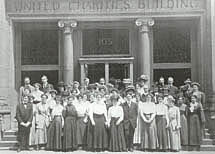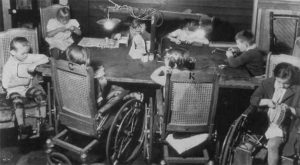Know your Social Work History: Pioneering Health Care for Children with Disabilities
A little unknown fact about me – one of my first scholarly interests as a future academic was and still is social welfare history; exploring the roots of the social work profession in the United States. As a doctoral student at the University of Alabama’s (UA) School of Social Work, I was fortunate enough to work with Dr. Paul Stuart, a leading social welfare historian and, now, Professor of Social Work at Florida International University. I took several classes with him about social welfare policy and historical research methodology. Along with being my academic advisor and chair of my dissertation committee, he helped me to develop an interest in how the history of social work profession has a direct and meaningful influence on today’s social workers and social welfare agencies. Through reading and research from my course work, I quickly learned that there was a gap in the social welfare history literature on the intersection of social work and public health in early 20th century in the United States. Using my background in public health and social work, I developed a research topic which turned into my dissertation and the foundation of my interest in social welfare history – the history of health and social services for children with disabilities.
I write all this because I just had a second article published from my dissertation research:
Hitchcock, L. I., & Stuart, P. (2017). Pioneering Health Care for Children with Disabilities: Untold Legacy of the 1916 Polio Epidemic in the United States. Journal of Community Practice. Retrieved from http://www.tandfonline.com/eprint/BDSf39bKsz2ffnn6zMFb/full
This article was a long time coming, seven years in the making, and describes how social workers, physicians, nurses, and philanthropists came together in the wake of 1916 polio epidemic to organize after-care services for children who survived the disease. Here is the abstract:
In 1916, the United States experienced its first polio epidemic, resulting in 6,000 deaths and 21,000 injured individuals. Medical practices were ill prepared to stop the disease and treat survivors. Historians have documented the creation of the polio vaccine during the 20th century, but less is written about efforts to provide rehabilitation services to children afflicted with polio. This research looked at Polio After-Care Committees, a new form of community practice that provided care to children with disabilities. The Committees worked to change community-level systems of care while providing medical care, demonstrating that new forms of community-based service organization could reach children.
These after-care committees represent one of the first community-based programs for children with disabilities and their influence can be seen in the development of the country’s first federal medical program for children, the Crippled Children’s Services (CCS) program in Title V of the 1935 Social Security Act (SSA). My dissertation research focused on how the inclusion of the CCS in the SSA, was, in part, the result of advocacy by social reformers and social work professionals during the progressive and New Deal eras. These reformers and professionals promoted societal and policy changes to protect women, children and other vulnerable populations from problems such as poor sanitation, inadequate nutrition, substandard housing and communicable diseases. Here is a link to my dissertation which includes other examples of early services for children with disabilities.
Hitchcock, L. I. (2009). The creation of federal services for crippled children, 1890-1941. The University of Alabama, Tuscaloosa, AL. Retrieved from http://libcontent1.lib.ua.edu/content/u0015/0000001/0000169/u0015_0000001_0000169.pdf
Once the federal CCS program was established, it quickly funded and supported state-level CCS programs all over the country, and over the next ten years, this federal program would develop unique innovative programs for children with disabilities, such as preventive care and interdisciplinary services. Central to the development of these programs was the inclusion of social workers as part of after-care services for children. My first publication from this research summarizes how these programs developed during their first years:
Hitchcock, L. I., & Mulvihill, B. A. (2011). The Early Years of Title V: Extending and Improving Care for Children with Special Health Care Needs, 1935–1941. Maternal and Child Health Journal, 15(2), 139–147. https://doi.org/10.1007/s10995-010-0695-3
Overall, these three works tell the story of why and how the CCS program was established during the 1930s and how it evolved during its first decade, focusing on the unique influences of social work reformers and professionals in developing medical and social services for children with disabilities during the 1930s and 1940s. At the time of my work, little research had been done on the development of specific maternal and child health programs under the early SSA, including the CCS program. These three works fill in the gaps of social welfare history in a few ways. A historical review of this program helps inform current state-level policies related to programs for children with disabilities, and recovered “lost” social welfare policy and practice for today’s social work practitioners, especially at the state-level. These insights also serve as a model for current and future social workers, by providing knowledge and inspiration about the work of early social work policy makers and practitioners at the state level.
While I won’t quit my other research interests, I have always enjoyed the intellectual challenge of historical research and helping to tell the story of the social work profession through time. I can’t tell you how much fun I had during my doctoral studies, going to national and regional archives and sifting through old documents written by some of our social work pioneers such as Julia Lathrop or Grace Abbott. If those women could write federal health care legislation for children back in the 1930s, surely we, today’s social workers, can do the same.
How to cite this post:
Hitchcock, L. I. (2017, February 1). Know your Social Work History: Pioneering Health Care for Children with Disabilities [Blog Post]. Retrieved from https://laureliversonhitchcock.org/2017/02/01/know-your-social-work-history-pioneering-health-care-for-children-with-disabilities/.




